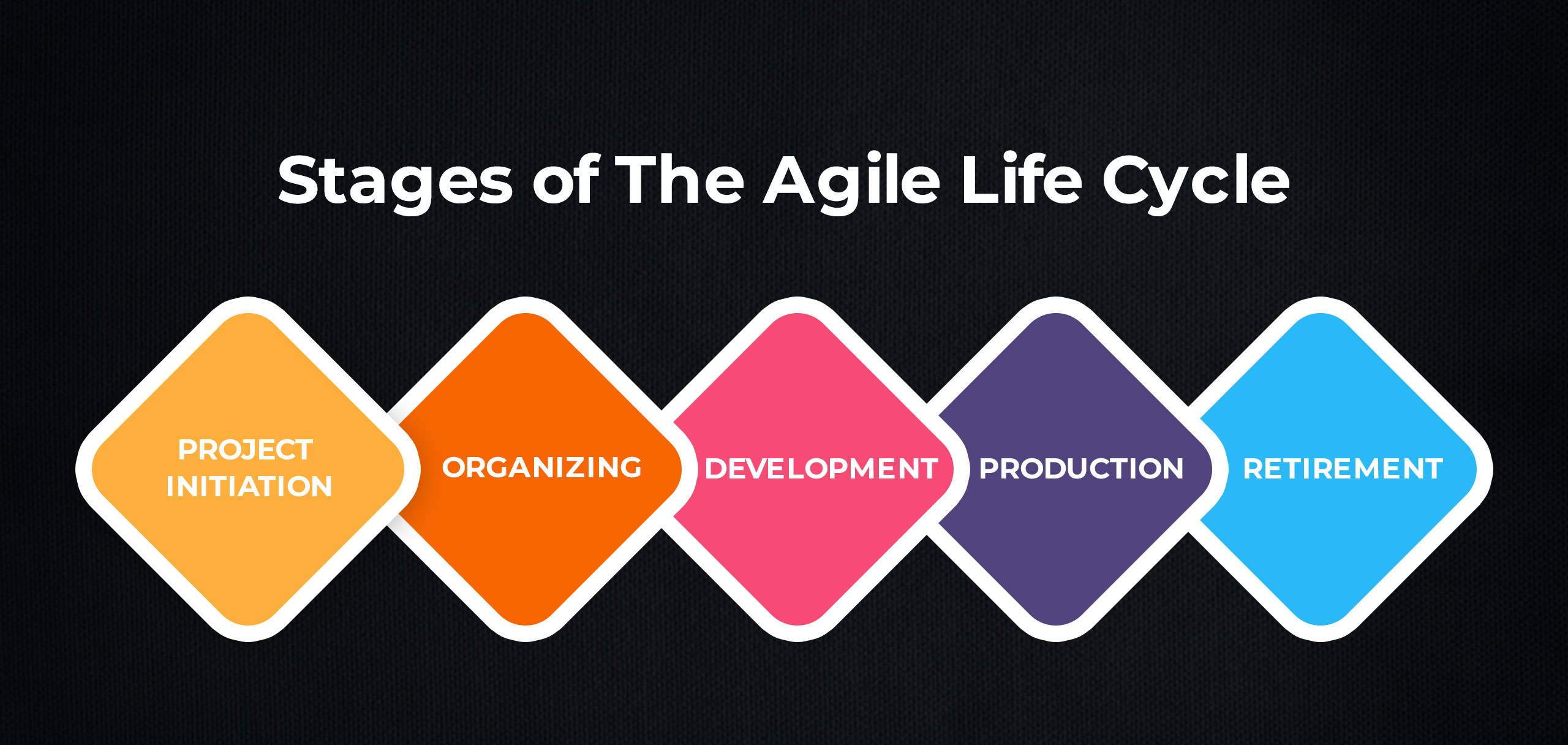5 Stages of the Agile System Development Life Cycle
Customer needs are changing quickly, especially in the software development industry. Agile software development adopts a methodical approach to the design and development of technologies in order to embrace ongoing change.
The Agile lifecycle gives a fluid and adaptable approach to producing a working product more structure.
You may offer a product that is considerably more valuable to your clients in a lot shorter amount of time by dividing your builds into smaller chunks.
Look at the Agile System Development Life Cycle’s five phases (SDLC).
5 stages of the Agile Life Cycle

- Project Initiation
The initial phase of the agile software development life cycle. This initial phase, also known as the inception or envisage phase, is where the project vision and ROI rationale are discussed. This is a high-level discussion of practicality; it does not get into particulars.
In this step, you should decide who will be on your team and how much time and labour will be needed to finish the project. Making a resource inventory is essential to establishing the project’s economic viability and approval.
- Organizing
The Agile lifecycle for the team really starts to take shape during this exploratory phase. The team meets with their sponsor or product owner during release planning to determine exactly what they want. They talk about how growing the backlog at the story level will make this achievable.
How the end-user might characterise the feature or product is a useful technique to approach the creation of tales. The kind of user, what they want from the product, and why should all be mentioned in the story.
It is important to think about this business potential in a larger framework. This will have an effect on the project’s functional and financial viability.
- Development
The actual work starts after the requirements have been established using input from the product owners and stakeholders. Agile product development creates working products of the highest quality in iterative or incremental phases.
With the goal of creating a useable, functional product at the end of the sprint, developers begin work on the first version of the product. This is far from being the final version, therefore it should just have the bare minimum of functionality. Future editions of the Agile lifecycle may include the addition of this capabilities.
In these sprints, teams can produce results by
- Cooperation with their group and key stakeholders.
- Maintaining quality by adhering to coding standards and style recommendations.
- Observing the priorities specified by the project’s stakeholders, who have complete control over the project’s scope, budget, and timeline.
- Delivering functional, but imperfect, goods at the end of each cycle
- Testing is ongoing!
It is now prepared to be released into production after having through the necessary number of sprints to develop from an early minimally viable product to a fully functional solution.
You should have completed testing after each cycle by this point in the Agile lifecycle, having gone through a number of iterations. You will need to make room for final testing because this isn’t always the case.
To find bugs, quality assurance (QA) should conduct the final testing and acceptance. In contrast to iteration testing, you may choose to include a small number of end customers in this testing.
It’s critical that this is taken into consideration in the timeline because there will almost certainly be some rework after testing to remedy any discovered flaws.
The main objective is to deploy your solution into production, though you may also wish to train end users or support personnel.
- Production
Now that your product has been released, end consumers are using it. In these early phases, it’s crucial to keep a tight eye out for any faults or flaws that testing may have overlooked. The production and support teams should exchange personnel and receive any necessary training.
Depending on the kind of product you’re producing, these last steps and handovers may change.
When the product is prepared for retirement, the production phase usually comes to an end.
- Retirement
The Agile lifecycle’s last phase. The product is currently reaching the “end of life” stage and will be stopped in manufacturing and discontinued (also known as “sunsetting”). Information on upgrading to newer releases or choosing different choices is provided to customers.
Several factors lead to the retirement of products. The majority of the time, this occurs because a newer release is being used or because an earlier release is no longer supported. In this situation, the more recent system might receive a few last, tiny software upgrades.
It might also be phased out because the product is no longer economically viable under the existing business model.
Moving from Waterfall to Agile

Some developers still favour the waterfall approach because to its predictability and known expenses. You are aware of both what you are purchasing and when it will be delivered.
The agility of the Agile methodology rests in its capacity to change as the build progresses. You will unavoidably offer a much better finished product if you have the flexibility to roll with the needs and setbacks of stakeholders. even if it doesn’t resemble what you initially thought it would!
There are no set guidelines, like with the majority of Agile processes. The aforementioned Agile system development lifecycle is not infallible and can be modified or tailored to your project’s or organization’s specific needs.
It can be challenging for certain firms to switch from waterfall to agile. Fully committing can be challenging, particularly if you have severe time or money constraints.
Because of this, cooperation and communication are crucial across the whole Agile Life Cycle. You may much more easily fully implement Agile if you define what is wanted and possible during initial planning (and every iteration).
Conclusion
Nettyfy Technologies offers a new technique to improve the effectiveness and precision of an IT project, which is useful. The majority of the top companies that offer bespoke software development opt for the Extreme Programming (XP) agile development methodology, which maximizes collaboration to reach greater and better business advantages in less time! To effectively complete your project, get in touch with us.


